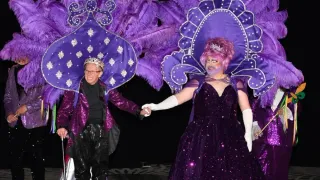
3 hours ago
The New Poly Etiquette: How Queer Communities Are Redefining Communication, Consent, and Ethical Non-Monogamy
READ TIME: 3 MIN.
Polyamory and other forms of ethical non-monogamy have a long but often overlooked history within queer communities. While non-monogamy is not exclusive to LGBTQ+ people, queer folks have been instrumental in developing new frameworks for relationships that center openness, negotiation, and collective well-being. Today, as polyamory becomes more visible and socially recognized, the need for clear etiquette—especially around communication and consent—has never been greater .
Many LGBTQ+ individuals report that traditional relationship models often fail to reflect their lived realities or desires for connection. For some, the very process of questioning heteronormative structures has led to embracing relationship diversity, including polyamory and open relationships . This critical stance has fostered a culture where intentionality, boundary-setting, and flexibility are paramount.
Queer-led polyamorous spaces often prioritize:
- Radical honesty: Open, ongoing communication about needs, desires, and boundaries .
- Informed consent: Ensuring all parties are fully aware and approving of relationship structures and agreements .
- Inclusivity: Creating environments where all identities—especially transgender, nonbinary, and asexual people—are respected and affirmed .
Effective communication is repeatedly cited as the cornerstone of successful non-monogamous relationships. In queer polyamorous circles, conversations about relationship expectations, emotional needs, and boundaries are not just encouraged—they are required . This may include:
- Regular check-ins with all partners about the state of the relationship and any evolving needs .
- Transparent discussions about safer sex practices and health status.
- Clearly articulated agreements, recognizing that these may change over time and require renegotiation .
Queer communities have also developed collective norms for negotiating invitations, introductions, and social gatherings. For example, polyamorous people may request that all partners be included in social invites where possible, or that hosts communicate openly about guest limits to avoid exclusion or awkwardness .
Consent within queer polyamory extends far beyond sexual activity. It is an ongoing process that includes emotional boundaries, autonomy, and the right to renegotiate agreements at any time . Some best practices emerging from LGBTQ+ poly spaces include:
- Affirmative consent: All participants must actively agree to any new relationship dynamics or activities.
- No coercion: Relationships are not forced into pre-set molds; each connection is allowed to develop organically, with input from all involved .
- Respect for autonomy: Individuals retain the right to say no, change their minds, or exit arrangements that no longer serve them.
- Privacy and discretion: Respecting each partner's need for privacy, especially when some may not be publicly out about their relationship status or sexual orientation .
Jealousy and insecurity are common challenges in any relationship, but queer polyamorous communities are developing unique tools to address these feelings. The emphasis is on self-reflection, open discussion, and mutual reassurance, rather than rules intended to suppress emotions . Rather than attempting to prohibit emotional connections, queer polyamory encourages partners to explore the roots of jealousy and build trust through vulnerability .
Despite growing social acceptance, polyamorous individuals—especially those who are visibly queer—face ongoing stigma and, in some cases, legal discrimination. Polyamorous families may encounter challenges related to child custody, housing, or employment, and a lack of legal recognition for non-traditional partnerships persists in many regions . Advocacy groups within the LGBTQ+ community are pushing for broader legal protections and destigmatization.
Queer-led polyamorous communities, both online and offline, provide crucial support, education, and resources. Groups such as local polyamory meetups, LGBTQ+ centers, and digital forums offer spaces to share experiences, troubleshoot challenges, and celebrate relationship diversity . These settings often feature:
- Workshops on communication, consent, and relationship skills.
- Peer-led discussions focused on intersectionality, addressing the unique experiences of queer, transgender, and BIPOC polyamorous people.
- Advocacy for inclusive policies within LGBTQ+ organizations and broader society.
As polyamorous relationships become more visible, queer communities are rewriting the rules of engagement—not just for themselves, but for anyone seeking alternatives to traditional monogamy. This evolving etiquette is rooted in respect, empathy, and a recognition of each person's full humanity. Rather than imposing rigid structures, the new poly etiquette invites flexibility, curiosity, and ongoing growth.
In practice, this means:
- Avoiding invasive or fetishizing questions about polyamorous people’s private lives .
- Normalizing conversations about mental health, sexual health, and emotional labor.
- Acknowledging and challenging the stigma that polyamorous and LGBTQ+ people continue to face.
- Encouraging allies to educate themselves and approach polyamorous people with the same respect and inclusion afforded to monogamous relationships .
The result is a dynamic, evolving set of social practices—one that is as diverse as the communities who create them. As queer folks continue to lead the charge, the new poly etiquette offers a model for ethical, joyful, and resilient relationships in a changing world.






